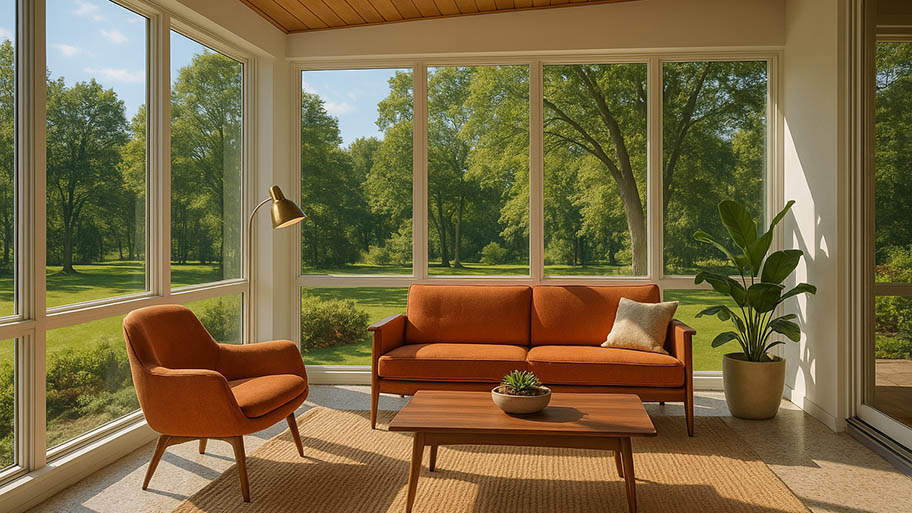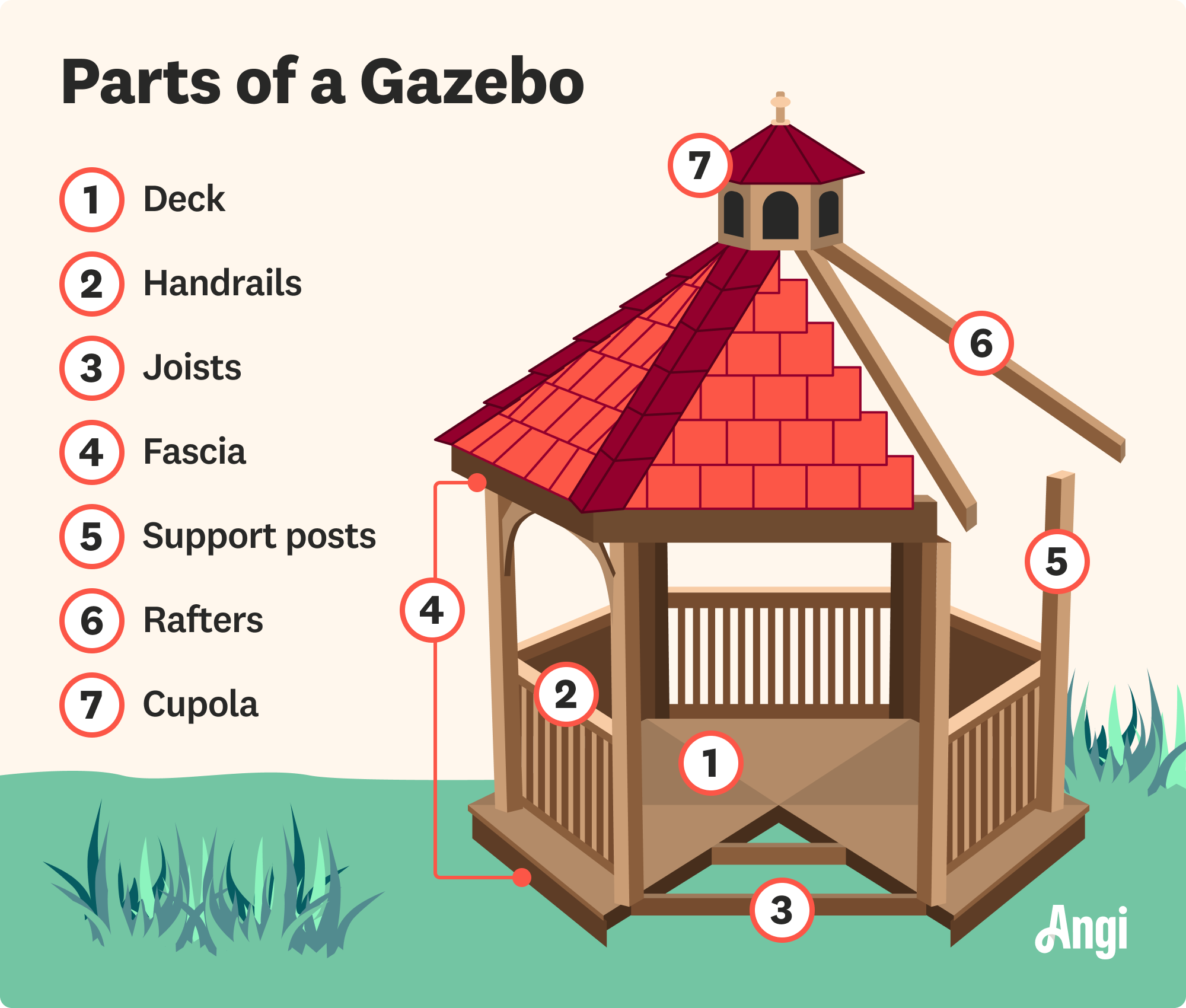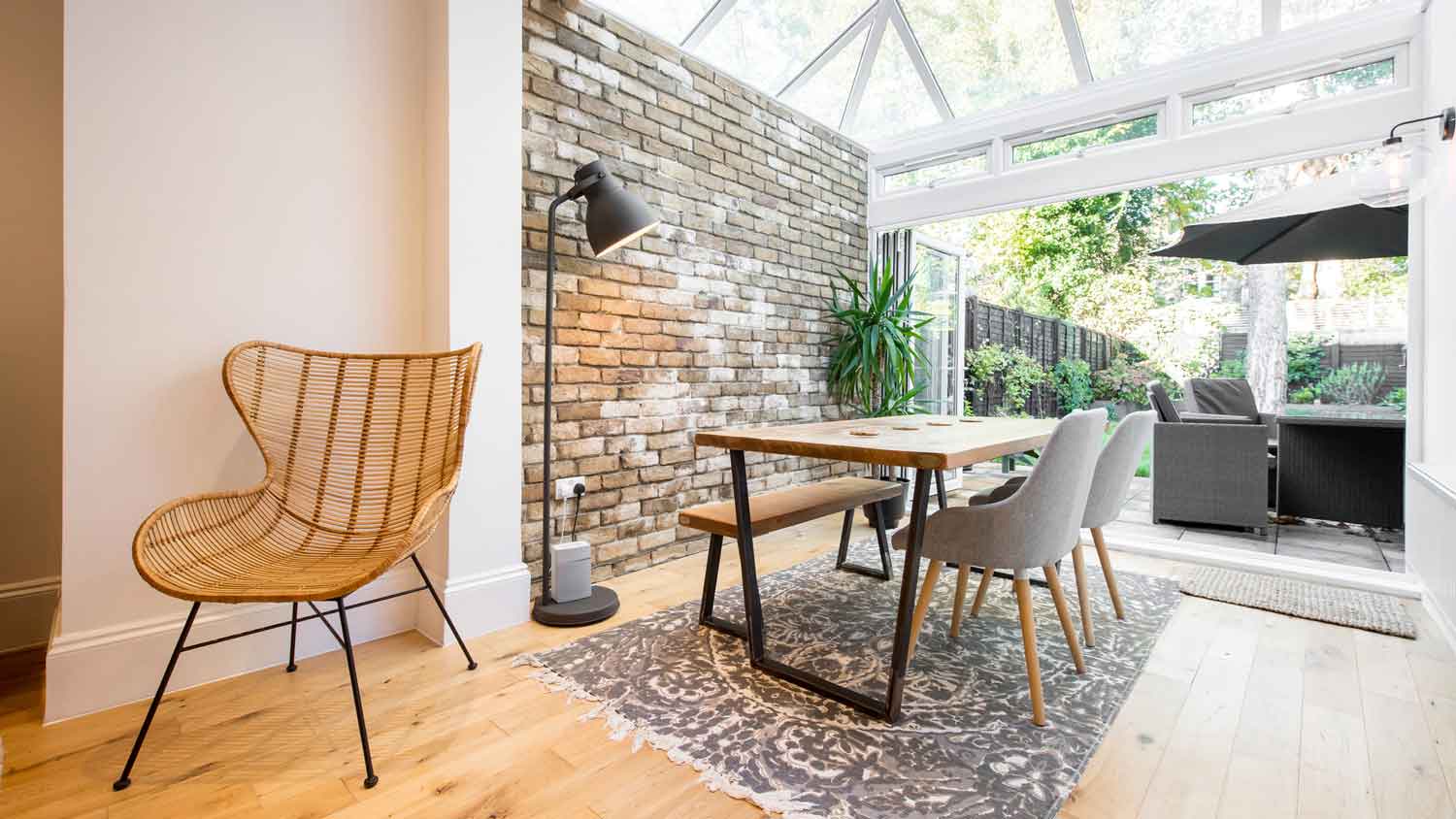
When you're ready to kick back and enjoy nature without the bugs, a sunroom is your best option. Learn how much a sunroom addition costs to set your budget.
Your outdoor furniture might not be the only thing you can put on a deck


Most decks can support the weight of a gazebo.
Some traditional wooden decks might be too weak to hold a gazebo.
Calculate your deck’s weight-bearing capacity to check its limits.
Putting a gazebo on a custom deck may require a pro’s help.
Whether you feel like your deck is missing something but can’t quite put your finger on it or you wish you could still enjoy the outdoors on a rainy day instead of just watching from the window, a gazebo might just be the perfect addition. If you’re unsure what type of gazebo would go best on your deck—or if you can put a gazebo on any kind of deck—this guide will answer your questions and help you make the most of every day outside.
A gazebo is a structure that accentuates outdoor landscaping by providing you with a stunning entertainment space that will quickly become your favorite part of the backyard.
Gazebos typically have a roof, open walls, and a central cupola (a hollow, cup-like formation on top) for ventilation that you can take advantage of rain or shine. Some gazebos have balusters (vertical beams like you’d see supporting stair handrails) or a wall panel, while others have a completely open space between the beams.
More permanent gazebos sit bolted onto a concrete slab, pavers, or deck. Others are pop-ups that you can assemble and disassemble for special occasions.
In most cases, you can install a gazebo on a deck. If your decking material is concrete, composite, or aluminum, your deck should be able to withstand the weight of a gazebo. Depending on the structure's weight, traditional wood decking might be unable to support a gazebo. If your deck doesn’t have the capacity to support the weight but you still want the stunning ambiance a gazebo has to offer, all might not be lost.
You may be able to install a gazebo over your deck using concrete footers on the base of your gazebo. For this to work, you’ll need a gazebo that overlaps your deck so that you can place the pavers beyond the perimeter of the deck. This might not be an option if you don’t have much extra space around your deck.
If you’re unsure whether your wooden deck can support a gazebo, you can figure it out with a little math.
Calculate the total square footage of your wooden deck.
Multiply the total square footage by 50. Generally speaking, a wooden deck can hold up to 50 pounds per square foot.
Look up the weight of your gazebo.
Ensure the total weight of your gazebo doesn’t exceed your deck’s maximum weight-bearing capacity.
If you live in a region with heavy snowfall, you should account for the snow load weight. Use a snow load calculator to determine the typical weight of snow in your region. Twelve inches of dry, fresh snow weighs approximately 5 pounds per square foot, for example.
Putting a gazebo on a raised deck may prove to be more challenging in terms of planning. You might want to ask a professional to help you construct a complex gazebo design on a custom deck.

Any structure you’re considering building on your property is a personal choice that boils down to your lifestyle, home goals, property size, and budget.
With this in mind, putting a gazebo on your deck can be a great way to upgrade your outdoor space for both personal enjoyment and ROI down the road—when you plan everything well and install it correctly.
However, this project may not be for everyone. Here’s a breakdown of the advantages and disadvantages of putting a gazebo on your deck to help you decide if it’s worth the planning and price.
If you put a gazebo on your deck, you’ll reap the following benefits:
If you were already planning on adding a gazebo, building one on your deck can help you save the money that you’d spend building an additional foundation.
By adding a gazebo to an existing feature, you can save space on your property for other landscaping elements.
Securing a gazebo to your deck adds extra stability in severe weather conditions.
You can enjoy the great outdoors from your deck under the shelter of a gazebo.
A gazebo can turn your deck into a great entertainment space.
At the same time, there are several disadvantages to installing a gazebo on a deck that are worth considering, such as the following:
You may need to buy a custom gazebo to match your deck’s design, which can increase your gazebo’s cost.
A wooden deck may be too weak to hold the weight of a concrete gazebo.
Deck repairs could be more challenging and costly when you add a gazebo into the mix.
You could damage your deck during the installation process.
A gazebo that’s too big for your deck could actually diminish your yard’s appearance and get in the way of some nature-watching.
It might be harder to maintain your deck, as parts of it will be less accessible.

Building a gazebo on a deck may be a worthy DIY project, depending on your skill level, type of deck, gazebo idea, and material. If your deck design fits perfectly with a prefabricated gazebo kit, installing it yourself will take some time, dedication, and a few helping hands, but it’s doable.
Pop-up or temporary gazebos may only need weights at the base of their posts, but this can scratch up wood planks, so you may want to avoid putting this type of gazebo on a wooden deck.
If you plan on DIY-ing the old-fashioned way instead of using a pop-up, here’s how to install a gazebo on a deck using bolts.
If you’re using a gazebo kit, you’ll need to assemble your gazebo. You can skip this step if you purchase a pre-assembled gazebo kit. Follow the instructions in the kit’s manual to install the gazebo.
The most common tools you’ll need to assemble your gazebo include a cordless drill, drill bits, rubber mallet, socket wrenches, tape measure, and work gloves for safety, but follow your specific instructions. You might want to build your gazebo on your deck so that you don’t need to transfer this heavy structure onto the deck later.
With your gazebo built and ready to go, you can now position it exactly where you plan on securing it to the deck. Mark where you will be anchoring your gazebo, then double-check the measurements to ensure your gazebo’s location is exactly where you want it, as once you drill into your deck, they’ll be permanent.
Gazebo kits don’t typically come with the supplies you need to secure them to a deck, though many come with metal footing for anchoring them down. Ensure you have bolts and galvanized or masonry screws on hand before you get ready to secure your gazebo.
Drill pilot holes (shallow holes you drill before placing in bolts to give them a guide and decrease the risk of wood splitting) where your bolts will go. You must secure the screws to decking joists—not any old board. Decking joists are structural boards in a grid-like pattern at the base of your deck, similar to studs in your home’s wall.
If you don’t do this step, you risk damaging your deck. Once you’ve drilled the pilot holes, secure the gazebo by drilling the bolts into the footer holes.
If you’re unsure how to install a gazebo on your deck, you might want to hire a professional gazebo builder near you to eliminate any guesswork or doubts you have about doing it yourself. You’ll especially want to consider hiring a pro for complex or custom designs.
Robert also provides my lawn care. He pays attention to detail, is a pleasure to work with. I am so happy with the patio he built and the lawn care he provides. Very trust worthy and fabulous!
I am writing this review for my sister as her sunroom is not yet finished and she is afraid of retaliation if she writes the review. My sister contacted ABC of Nebraska well over 1 year ago to build a sunroom for her. ABC of Nebraska FINALLY started the project in November, again, over 1 year...
He was very personable and punctual.
I had Elite out to quote installing an inline duct booster since our upstairs had low airflow and I was pretty sure I'd tried everything on the dampers downstairs to balance it out. Turns out I'm not as clever as I thought—Trevor went through and figured out that the line I thought was the...
They did an excellent job! Every single worker was very friendly and professional, very careful with our plants in the yard. Did a great and safe job removing dead and dangerous branches and even cleaned up after themselves. Price was very reasonable as well; we'd hire them again in a heartbeat!
My back yard slopes considerably down and away from the back of the house and an unsightly/unstable retention mound of rubble and soil left the area close to the back of the house and under the 2nd story high deck pretty much unusable. Jeremy removed the rubble, reshaped the nondescript...
I was very pleased with the work and the company. The people I had talked to on the phone were polite and pleasant, and the electrician who ran the line was a very nice person, and explained all of my questions completely. It only took a day (not counting a holiday) for them to come out and...
From average costs to expert advice, get all the answers you need to get your job done.

When you're ready to kick back and enjoy nature without the bugs, a sunroom is your best option. Learn how much a sunroom addition costs to set your budget.

Use our expert guide to figure out how much it costs to install a pool enclosure. Establish your budget, then plan your pool enclosure project.

While a solarium addition costs homeowners a fair amount of money, the return on investment is higher than most projects. Learn what affects the total cost and where you can save money.

Not sure what type of sunroom to build? Our guide breaks down the differences between a solarium vs. sunroom so you can decide which is best for your home.

From inflatable domes to self-built structures, DIY pool enclosures are a doable home project. Here's how to approach the project like a pro.

Discover the cost to install a conservatory to learn about average prices, key cost factors, and ways to save before starting your conservatory project.